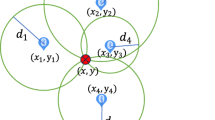Abstract
The Wi-Fi fingerprint, which can be used on existing wireless networks, is one of the main indoor positioning techniques that utilizes the received signal strength (RSS). In smartphones, the positioning performance of the fingerprint has been significantly improved through fusion algorithms along with terrestrial magnetism and acceleration sensors. However, the positioning accuracy and speed of the fingerprint is based on radio maps. Although these maps are separate databases obtained without using these sensors, they are important reference elements for initial position estimation and sensor error compensation. In order to minimize the DB of fingerprint and to improve the speed of system construction according to the area of positioning is expanded, this paper proposes a Wi-Fi fingerprint using a radio map construction model based on the minimum description length principle, which can automatically optimize radio maps and the Euclidean distance algorithm based on the Chi squared test. Unlike the existing RSS-classification-based radio map construction method, the proposed access point (AP) classification-based radio construction model not only automatically distinguishes the continuity of all the RSSs acquired from the APs but also optimizes the radio map by eliminating unnecessary APs, based on the information gain. In the positioning phase, based on the proposed radio map, the accuracy of the signals is distinguished using a Chi squared test for the AP RSSs measured in real-time. Therefore, the Euclidean distance, based on the Chi squared test, improves the positioning performance by determining the position accuracy using weighted values of the RSSs, with high reliability.









Similar content being viewed by others
References
Arain, Q. A., Memon, H., Memon, I., Memon, M. H., Shaikh, R. A., & Mangi, F. A. (2017). Intelligent travel information platform based on location base services to predict user travel behavior from user-generated GPS traces. International Journal of Computers and Applications, 39, 1–14.
Arain, Q. A., Deng, Z., Memon, I., Zubedi, A., & Mangi, F. A. (2017). Map services based on multiple mix-zones with location privacy protection over road network. Wireless Personal Communications, 97(2), 2617–2632.
So, J. M., Lee, J. Y., Yoon, C. H., & Park, H. J. (2013). An improved location estimation method for Wi-Fi fingerprint-based indoor localization. International Journal of Software Engineering and Its Applications, 7(3), 77–86.
Arai, K., & Tolle, H. (2013). Color radio map interpolation for efficient fingerprint WiFi-based indoor location estimation. International Journal of Advanced Research in Artificial Intelligence, 2(3), 10–15.
He, J., Geng, Y., Liu, F., & Xu, C. (2014). CC-KF: Enhanced TOA performance in multipath and NLOS indoor extreme environment. IEEE Sensors Journal, 14(11), 3766–3774.
Ahmed, H. I., Wei, P., Memon, I., Du, Y., & Xie, W. (2013). Estimation of time difference of arrival (TDoA) for the source radiates BPSK signal. IJCSI International Journal of Computer Science Issues, 10(3), 1694–1784.
Seong, J.-H., Choi, E.-C., Lee, J.-S., & Seo, D.-H. (2017). High-speed positioning and automatic updating technique using Wi-Fi and UWB in a ship. Wireless Personal Communications, 94(3), 1105–1121.
Yiu, S., Dashti, M., Claussen, H., & Perez-Cruz, F. (2017). Wireless RSSI fingerprinting localization. Signal Processing, 131, 235–244.
Jung, S.H., Moon, B.-C., & Han, D. (2017). Performance evaluation of radio map construction methods for Wi-Fi positioning systems. IEEE Transactions on Intelligent Transportation Systems, 18(4), 880–889.
Figuera, C., Rojo-Álvarez, J. L., Wilby, M., Mora-Jiménez, I., & Caamaño, A. J. (2012). Advanced support vector machines for 802.11 indoor location. Signal Processing, 92(9), 2126–2136.
Jiang, Q., Ma, Y., Liu, K., & Dou, Z. (2016). A probabilistic radio map construction scheme for crowdsourcing-based fingerprinting localization. IEEE Sensors Journal, 16(10), 3764–3774.
Kjærgaard, M. B. (2007). A taxonomy for radio location fingerprinting. In International Symposium on Location-and Context-Awareness. Berlin: Springer.
Mirowski, P., Ho, T. K., & Whiting, P. (2014). Building optimal radio-frequency signal maps. In 2014 22nd International Conference on Pattern Recognition (ICPR). IEEE.
Jiang, Q., Ma, Y., Liu, K., & Dou, Z. (2016). A probabilistic radio map construction scheme for crowdsourcing-based fingerprinting localization. IEEE Sensors Journal, 16(10), 3764–3774.
Kim, Y., Shin, H., Chon, Y., & Cha, H. (2015). Crowdsensing-based Wi-Fi radio map management using a lightweight site survey. Computer Communications, 60, 86–96.
Chang, K., & Han, D. (2014). Crowdsourcing-based radio map update automation for wi-fi positioning systems. In Proceedings of 3rd ACM SIGSPATIAL International Workshop Crowdsourcing Volunteered Geographic Information (pp. 24–31).
Laoudias, C., Eliades, D. G., Kemppi, P., Panayiotou, C. G., & Polycarpou, M. M. (2009). Indoor localization using neural networks with location fingerprints. In Proceedings of the 19th International Conference on Artificial Neural Networks: Part II, ser. ICANN’09 (pp. 954–963). Berlin: Springer.
Brunato, M., & Battiti, R. (2005). Statistical learning theory for location fingerprinting in wireless lans. Computer Networks, 47(6), 825–845.
Wu, Z., Fu, K., Jedari, E., Shuvra, S. R., Rashidzadeh, R., & Saif, M. (2016). A fast and resource efficient method for indoor positioning using received signal strength. IEEE Transactions on Vehicular Technology, 65(12), 9747–9758.
Tran, D. A., & Pham, C. (2014). Fast and accurate indoor localization based on spatially hierarchical classification. In 2014 IEEE 11th International Conference on Mobile Ad Hoc and Sensor Systems (MASS) (pp. 118–126). IEEE.
Acknowledgements
This research was supported by Basic Science Research Program through the National Research Foundation of Korea (NRF) funded by the Ministry of Education (Grant No. 2016R1D1A1B03934812).
Author information
Authors and Affiliations
Corresponding author
Rights and permissions
About this article
Cite this article
Seong, JH., Seo, DH. Wi-Fi fingerprint using radio map model based on MDLP and euclidean distance based on the Chi squared test. Wireless Netw 25, 3019–3027 (2019). https://doi.org/10.1007/s11276-018-1700-9
Published:
Issue Date:
DOI: https://doi.org/10.1007/s11276-018-1700-9




